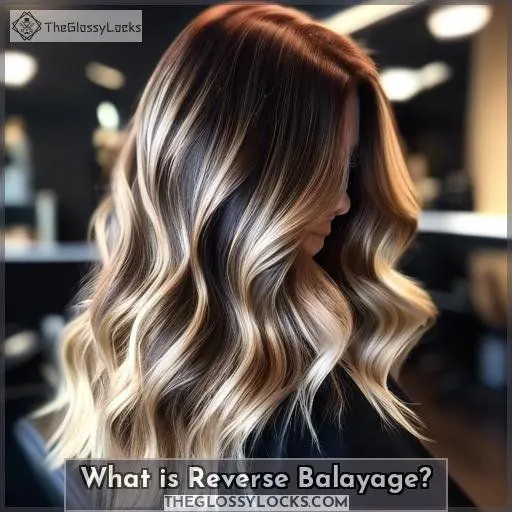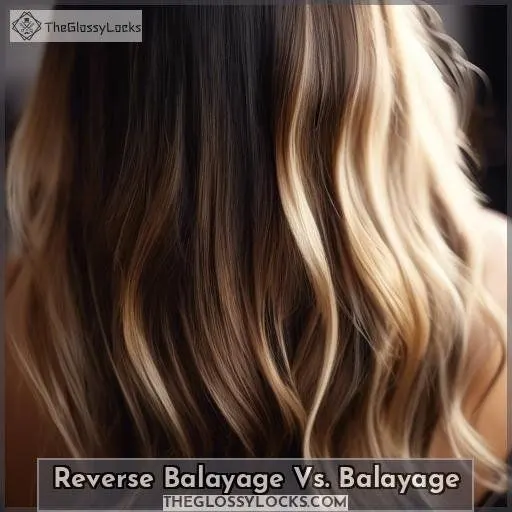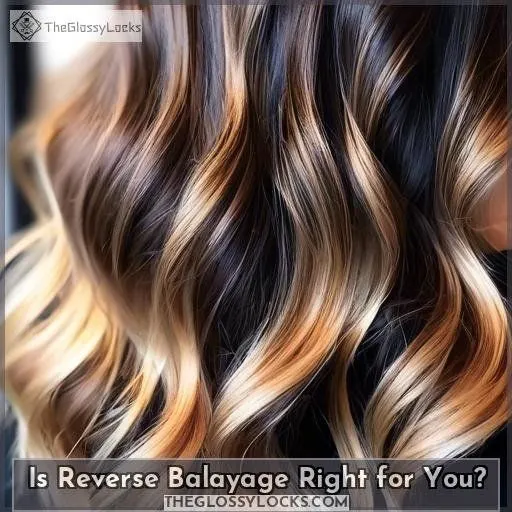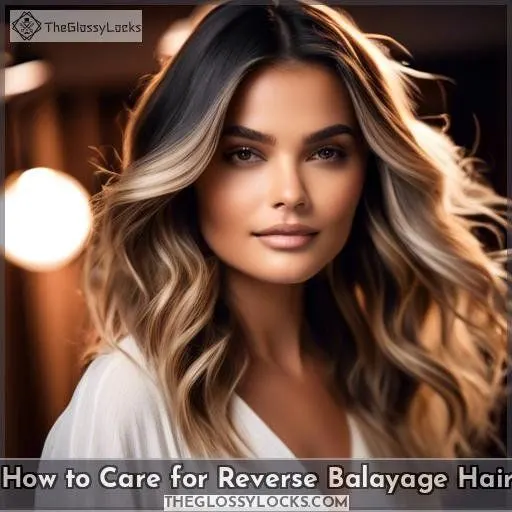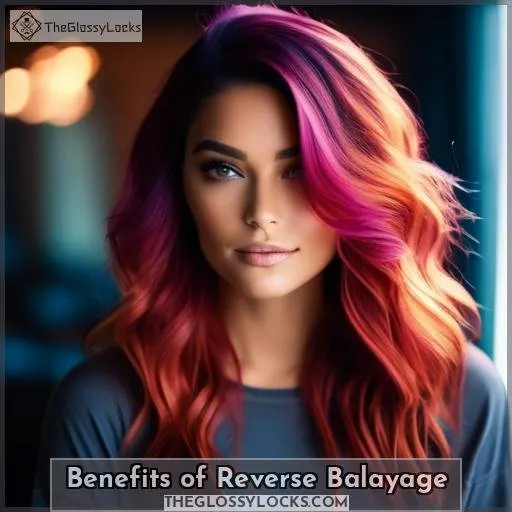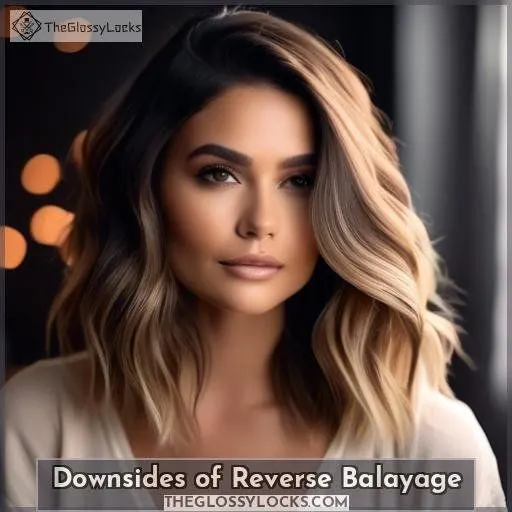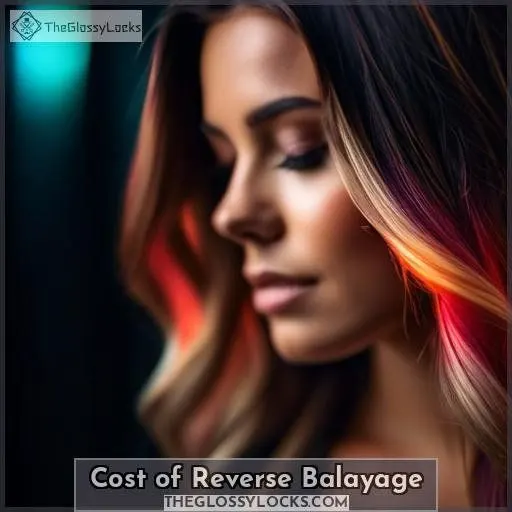This site is supported by our readers. We may earn a commission, at no cost to you, if you purchase through links.
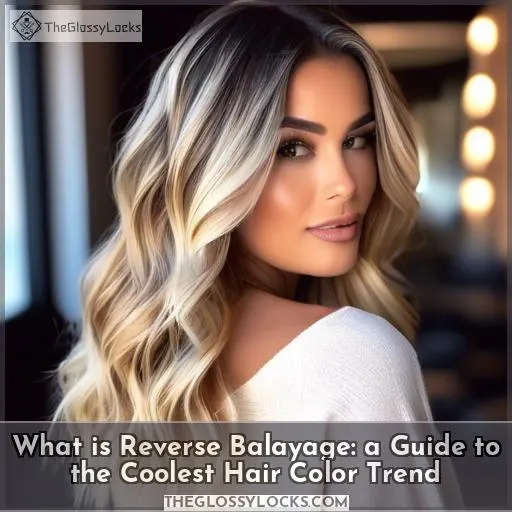 Over 60% of blondes crave a richer, more dimensional hair color.
Over 60% of blondes crave a richer, more dimensional hair color.
Introducing: reverse balayage—the hair trend adding depth to blonde tresses.
You’ll leave the salon with darker, sun-kissed strands blending into lighter roots for a lived-in, low-maintenance look.
This process allows you to embrace your natural hues while retaining pops of brightness.
Achieve multidimensional blonde perfection through reverse balayage’s strategic highlights and lowlights.
Table Of Contents
- Key Takeaways
- What is a Reverse Balayage ?
- What is Reverse Balayage?
- Reverse Balayage Vs. Balayage
- Is Reverse Balayage Right for You?
- How to Care for Reverse Balayage Hair
- Benefits of Reverse Balayage
- Downsides of Reverse Balayage
- Cost of Reverse Balayage
- Frequently Asked Questions (FAQs)
- What is the difference between reverse balayage and traditional balayage?
- How does reverse balayage blend roots and create a more lived-in, natural hair color?
- What hair color products are used in reverse balayage versus traditional balayage?
- Who are the ideal candidates for reverse balayage, and what hair types, textures, and skin tones is it suitable for?
- How does reverse balayage compare to ombre and sombre hair color trends?
- Conclusion
Key Takeaways
- Reverse balayage darkens the roots and mid-lengths of the hair using permanent hair dye, contrasting with traditional balayage that lightens hair with bleach.
- It is designed to add depth and dimension, creating a more natural, lived-in look that is particularly suitable for blondes or those with light brown hair.
- This technique is low-maintenance, making it an ideal choice for individuals seeking a darker, more natural hair color without frequent salon visits.
- The process is customizable, allowing for a variety of looks that cater to individual preferences while enhancing the hair’s natural beauty.
What is a Reverse Balayage ?
Reverse balayage is a hair coloring technique that involves painting darker shades on the roots and sometimes mid-lengths of the hair to add depth and dimension. Unlike traditional balayage, which lightens the ends of the hair, reverse balayage works by reversing some of the lightness from the roots to mid-lengths.
This technique is particularly popular among blondes or people with lighter brown hair, as it helps to make blonde hair appear more natural and extends the time between touch-ups.
What is Reverse Balayage?
Reverse balayage is a hair coloring technique that adds depth and dimension to your mane without the need for frequent touch-ups.
Unlike traditional balayage, which lightens your strands, reverse balayage uses permanent hair dye to darken your roots and mid-lengths, creating a more lived-in, natural look.
This technique is ideal for those seeking a darker, low-maintenance hair color, especially for blondes or those with light brown hair.
It’s a great way to enhance highlights and make blonde hair appear more natural.
Reverse Balayage Vs. Balayage
Reverse balayage and traditional balayage are two different hair coloring techniques that offer distinct outcomes.
While traditional balayage involves lightening the hair, reverse balayage uses permanent hair dye to add darker shades to the roots and mid-lengths of the hair.
The result is a more natural, subtle look that adds depth and dimension to the hair.
Reverse balayage is suitable for blondes or light brown hair, as it can make blonde hair appear more natural and extend the time between touch-ups.
It’s also a low-maintenance hair color option for anyone seeking a darker mane.
Coloring Product Used
When it comes to the coloring products used in reverse balayage, there are key differences compared to traditional balayage:
- Coloring Product Used:
- Reverse balayage utilizes permanent hair dye instead of bleach, adding depth and dimension without lightening the hair.
- Balayage, on the other hand, involves lightening strands with bleach to create highlights.
- The choice between these techniques depends on your desired outcome, colorist experience, and hair texture.
Overall Outcome
When comparing the overall outcome of Reverse Balayage to traditional Balayage, the key difference lies in the effect on hair color.
While Balayage lightens hair, Reverse Balayage darkens it, creating a stunning contrast.
This technique adds depth and dimension, enhancing highlights and blending seamlessly with natural hair tones.
The versatility of Reverse Balayage allows for a more natural look, making it a popular choice for those seeking a slightly darker shade.
Is Reverse Balayage Right for You?
Transitioning from the nuanced differences between reverse balayage and traditional balayage, you might be wondering if this trend is the right fit for your locks. Let’s dive into the heart of whether reverse balayage can be your next hair adventure.
-
Consider Your Lifestyle: If you’re someone who loves a stunning look without the constant salon visits, reverse balayage is a beacon of low maintenance. Its ability to add depth while extending time between touch-ups means more freedom for you.
-
Assess Your Hair: Whether you’re rocking curls, waves, or straight strands, reverse balayage plays well with all hair types. However, keep in mind that the technique involves color, not bleach, which can be gentler on your hair but still requires a thoughtful look at your hair’s health and texture.
-
Match Your Skin Tone: The beauty of reverse balayage lies in its color versatility, seamlessly blending with your skin undertones for a natural look that feels like you, only better.
How to Care for Reverse Balayage Hair
How to Care for Reverse Balayage Hair
After getting a reverse balayage, it’s essential to maintain your hair’s vibrancy and health.
-
Use Color-Safe Shampoo and Conditioner: Always use a shampoo and conditioner formulated for color-treated hair. This will help preserve the color and prevent it from fading too quickly. Moroccanoil Color Continue Shampoo and Conditioner are great options.
-
Hair Gloss: Use a hair gloss to enhance your color and tone. The L’Oréal Paris Le Color Gloss One Step In-Shower Toning Gloss is an excellent choice.
-
L’Oréal Paris Elvive Color Vibrancy Products: The L’Oréal Paris Elvive Color Vibrancy Protecting Shampoo, L’Oréal Paris Elvive Color Vibrancy Protecting Conditioner, and L’Oréal Paris Elvive Color Vibrancy Repair and Protect Balm are all recommended for maintaining your reverse balayage.
-
Avoid Heat Styling: Try to avoid using heat styling tools as much as possible. If you must use them, use a heat protectant spray first.
Benefits of Reverse Balayage
Reverse balayage is a hair color technique that adds depth and dimension to your hair, creating a more natural, lived-in look.
It’s a low-maintenance alternative to traditional balayage, which focuses on lighter hues.
Reverse balayage uses permanent hair dye instead of bleach and adds color back into the hair, forming a new dimension by playing with shadows and darker shades.
It’s suitable for blondes or light brown hair, making blonde hair appear more natural and extending the time between touch-ups.
Additionally, it’s a great option for anyone wanting a darker mane and is low-maintenance.
Natural Depth and Dimension
To achieve a stunning blonde ombre hair trend with natural depth and dimension, you can opt for reverse balayage.
This technique uses a hand-painted method to create a gradual transition from darker shades at the roots to lighter ones at the ends.
It offers a seamless application that blends with your hair texture and skin tone, providing a more natural appearance.
The ombre effect adds dimension and enhances the color blending, making it low-maintenance and suitable for various hair types and skin tones.
Low-Maintenance Hair Color
Building on the allure of natural depth and dimension, reverse balayage stands out as a low-maintenance hair color marvel.
- Root Touch-Up Relief: Stretch out salon visits.
- Natural-Looking: Seamlessly blends into your lifestyle.
- Darker Roots: A subtle nod to your inner rebel.
- Enhances Blonde: Brightens your light, effortlessly.
Suitable for Blondes
| Benefits | Details |
|---|---|
| Natural effect | Reverse balayage adds depth and dimension, giving your blonde hair a more natural look. |
| Low-maintenance | This technique extends the time between touch-ups, making it perfect for those who want a stylish yet practical hair color. |
| Seasonal hair color | Reverse balayage is a low-commitment way to change your hair color for the season, and it’s easy to revert to your previous color. |
So, if you’re a blonde seeking a slightly darker shade with minimal upkeep, reverse balayage might just be your ticket to stunning, hassle-free hair.
Downsides of Reverse Balayage
- Darkening effect: Reverse balayage involves adding darker shades to your hair, which can be a significant change if you’re used to lighter colors.
- Increased maintenance and touch-ups: While reverse balayage is generally low-maintenance, you may still need to touch up your roots as they grow out.
- Higher cost: The cost of reverse balayage can vary depending on the salon and the colorist’s experience, but it may be more expensive than traditional highlights.
- Hair damage: As with any coloring technique, there’s a risk of damage to your hair, especially if it’s already dry or damaged.
- Colour loss: Over time, the darker shades in your reverse balayage may fade, which can result in a less dramatic effect.
If you’re still interested in reverse balayage, it’s essential to consult with a professional colorist to ensure that your hair is healthy enough for the process and that you’re getting the look you want.
- Use a sulfate-free shampoo and conditioner formulated for color-treated hair.
- Try to wash your hair less frequently to preserve the color.
- Use a heat protectant when styling your hair with hot tools.
- Avoid hot water when washing your hair, as it can strip the color.
- Schedule regular trims and touch-ups to keep your reverse balayage looking fresh.
Cost of Reverse Balayage
After exploring the benefits and considerations of reverse balayage, let’s delve into the cost of this stunning hair color technique.
The price of reverse balayage can range from $150 to $500, depending on several factors. These factors include the experience of your stylist, the location of the salon, the length and color of your hair, and whether you opt for a partial or full balayage.
To help you better understand the cost, here’s a simple table that breaks down the pricing based on hair length and balayage type:
| Hair Length | Partial Balayage | Full Balayage |
|---|---|---|
| Short | $70 – $130 | $150 – $200 |
| Medium | $150 – $200 | $200 – $300 |
| Long | $200 – $300 | $300 – $500 |
For medium-length hair, balayage typically falls within the average price range of $150 to $200. Longer hair, however, tends to be more expensive, potentially reaching up to $300 or more for a full balayage.
While reverse balayage can be pricey, its stunning results and ease of maintenance make it an excellent choice for those seeking a stylish and practical hair color. By understanding the factors that influence the cost, you can make an informed decision and find a salon and stylist that fits your budget and expectations.
Frequently Asked Questions (FAQs)
What is the difference between reverse balayage and traditional balayage?
You’ve got it – reverse balayage adds darker tones to your blonde locks, while traditional balayage lightens hair.
How does reverse balayage blend roots and create a more lived-in, natural hair color?
You’ll get a natural-looking blend from roots to ends. The gradual transition adds depth for a lived-in vibe.
What hair color products are used in reverse balayage versus traditional balayage?
Reverse balayage uses semi-permanent hair dyes instead of bleach like traditional balayage.
Who are the ideal candidates for reverse balayage, and what hair types, textures, and skin tones is it suitable for?
Like a sunrise streaking the sky, reverse balayage adds depth to blondes effortlessly. You’re the flawless candidate – any hair type or tone suits this lived-in, customizable look.
How does reverse balayage compare to ombre and sombre hair color trends?
Reverse balayage subtly blends darker tones into blonde hair, unlike ombre’s stark contrast or sombre’s gradual, seamless blend.
Conclusion
Like a sunrise painting your hair with warm hues, reverse balayage is a stunning way to achieve multidimensional blonde. You’ll radiate natural depth and dimension while enjoying low-maintenance tresses.
Embrace your roots and crave-worthy pops of brightness by delving into this strategic coloring technique – the perfect blend of lived-in allure and sun-kissed perfection.

